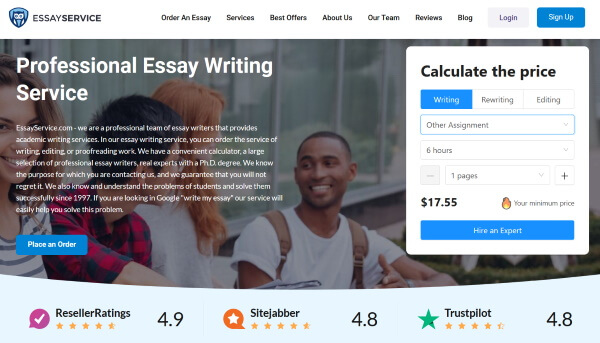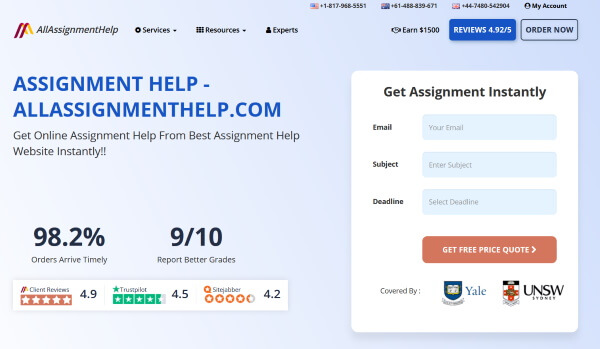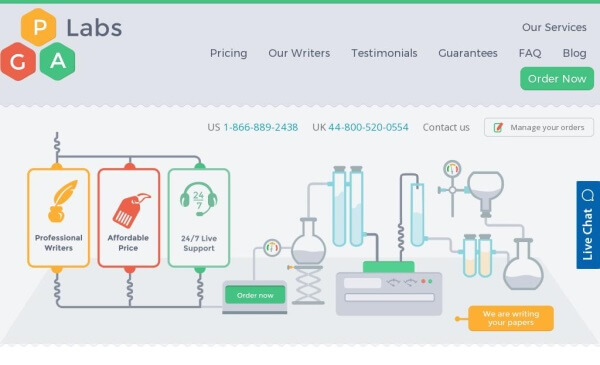When you are doing homework late at night with matches holding your eyelids, you need to know one thing. There is a way to do it faster and easier. Even if you now feel desperate and lonely, you need to know that you are not alone. Somewhere out there, on the other side of your laptop screen (or maybe even on the other side of the planet), there is an expert writer who may save you.
Assignment writing services were invented for students who may lack time for doing tens and hundreds of papers teachers are thoughtlessly throwing at them. Who cares if you have other things to do? Who cares if you juggle work and study and have been sleep deprived for months? It is up to you to worry about your health and find the best ways to optimize your study process. In that regard, 24/7 online writing services can be a universal solution to myriads of homework problems.
At the same time, you need to be careful when choosing an appropriate service provider. The main criteria for your choice should be confidentiality, security, and quality guarantees. These parameters have been considered for compiling the following list of top 20 most reliable assignment writing services, selected and recommended by students.
1.
The website claims that their assignment writing service is paradise of excellence for students. The mission of this company is to enhance your academic achievements and career. The reputation of clients is the main priority of this service. For this reason, the company employs only the best-accredited writers and editors. With this company, students are eligible for free unlimited amendments and money back guarantee.

Pricing: Prices range from $9 to $59 per page, depending upon quality standard, deadline and type of paper.
Customer Reviews:
“I had many research for a top assignment writing company, and found most of the customer given positive comments for ExtraEssay.com. So, I trusted them and made my first orders to them.it was interesting and really top quality papers I got form them. They provide free draft for without any payment, which helps to verify the writing quality.” – Michelle T.
“The writers at ExtraEssay are the best of the best and so easy to reach via phone or chat. They make it a point to give individual attention to each and every student. Service is the motive for sure.” – ANGIE M.
2. AssignmentWriting.Services
In the years of their experience in this niche, this company has witnessed the evolution of writing services. They are continuously upgrading and improving the quality of their services. The company offers the innovative features and freebies, which make your cooperation with them effective and unforgettable. Their main characteristics are professionalism and perfection, which are highly rated and approved by their repeated users.

Pricing: Pricing depends upon academic level. Particularly, undergraduate students can enjoy papers at $11 per page, while PhD writing costs $18 per page, and admission help costs $34 per page.
Customer Reviews:
“My assignment had to be very good because my departmental head was a famous economist and it was very hard to make any impression on him. I struggled throughout the year until a desperate search led to AssignmentWriting.Services. The reference assignment they provided was meticulously written and proved extremely helpful. I owe my master’s success to assignment writing services.” – Tony R.
“I trust these guys because no matter what topic or kind of paper I had, they have done their best to deliver perfect assignment. Only couple of my papers were returned for revision by professor. But it absolutely didnt change my opinion about the website.” – Evelyn S.
3. UniPapers.org
The company offers assistance of expert academic writers with various types of academic assignments. The service emphasizes their intention to deliver papers within the chosen deadlines. Additionally, the company provides flawless writing at affordable prices. The delighted feedback of their happy clients is the best proof of their quality services.

Pricing: The main parameters used by the website price calculator include assignment type, urgency and number of pages. The price of a fourteen-day essay of standard quality is $12 per page. Meanwhile, an urgent PhD dissertation costs $35 per page.
Customer Reviews:
“I was feeling completely exhausted after writing so much without a break, I wished if someone could help me write and there was this UniPapers company online. They finished my assignments and the best part was that they gave me an introductory discount. I’m completely satisfied with their writing service.” – Sean Mayor
“A breath of fresh air for a change! I’ve had some bad experiences with other writing services in the past who always delayed my assignments. I’m sticking with you guys from now on.” – Alastair
4. MyAssignmentHelp.com
My Assignment Help is a reputable online writing service that can help with any problems in assignment writing. As one of the top writing companies in Australia, this website helps students from all over the world. The company employs over 3000 expert writers, holding PhD or other degrees. Writers’ knowledge, experience and creativity are central characteristics, which make this service one of the best in its niche. The company guarantees the best price possible.

Pricing: Pricing depends upon hour rate of the writer you select as well as other factors, including urgency, subject and complexity level.
Customer Reviews:
“I ordered my English and Philosophy assignments from them last week. I received the solutions on the promised dates. Most importantly, the solutions were perfectly written. I found all the required information there. I was very tensed about the plagiarism issue. But these guys delivered me 100% plagiarism-free help material. I got A+. I am very happy. Their experts are just awesome.” – Olivia J.
5. EssayService.com
This US-based assignment writing service offers affordable prices on writing assistance of premium quality. With this website, your privacy and satisfaction with the quality are guaranteed. Their live chat is available 24/7 and it allows placing even the most urgent assignments with them. All papers received from this company are plagiarism and error free.

Pricing: Prices start at $11.7 per page and can go as high as $17.55 per page if you decide to choose rush 6-hour delivery.
Customer Reviews:
“This is the best assignment writing service provider company I have ever seen. The quality of the assignment provided by EssayService.com is just unbeatable. You should try this company at least once.” – Emi L.
“Got a timely response for my paper. The deadline was looming over my head. Thanks for saving my grade.” – Davinia
6. Studybay.com
This online writing company is well known for its premium quality of writing. Original papers received from this writing service can boost your academic performance and mood. With their international team of writers who live in the different corners of the world, the service is available 24/7. Plagiarism is out of the question, as every paper passes through careful plagiarism check procedure.

Pricing: Prices start at only $15.00 per page and depend upon urgency, topic and word count.
Customer Reviews:
“I had completely forgotten about my essay assignment until the very last day! I was so worried and did not know what to do! I used Studybay.com to write a custom paper for me and I got my paper delivered to me in time. It was a perfect paper!” – Elizabeth
7. BritishAssignmentWriters.co.uk
This online writing service offers invaluable help to anyone who has homework troubles. They complete every paper within the deadline and write every paper from scratch to comply with your individual requirements. The company provides original content and focuses on your result and complete satisfaction. Additionally, this company offers editing and proofreading services that may boost the quality of your projects.

Pricing: The two main parameters that influence the price are deadline and quality standard. The cheapest service is 2:2 standard one week essay ($8.99 per page), while the most expensive one is 24-hour delivery of a first class paper ($27.99 per page).
Customer Reviews:
“Sometimes Im not able to complete off work regardless of receiving extensions because of facing unexpected illness, I have taken help from British Assignment Writers has often aided such college students in such regards and has provided them impeccable assignment aid and guidance.” – Jordan L.
8. HomeworkHelpGlobal.com
Homework Help Global is one of the leaders in custom writing services. They serve students worldwide, making their lives easier and academic careers more successful. The website has no limitations in subjects and study levels. Their writers team is reliable and highly specialized. The service has high writing standards, which ensure proper quality and originality of the projects you receive.

Pricing: Pricing depends upon deadline and academic level. Prices start from $24.99 per page and can go up to $59.99 per page, depending upon deadline and study level.
Customer Reviews:
“I am very glad to find out about Homework Help Global. Their team is very professional and helpful. Service and work they provide is exceptional. It has helped me to advance in my academic career as well. Their services are highly recommended to students all around the world who need help and would like to succeed in their academic career. Thank you for the great work you do, always happy to use your services.” – Mamie
9. EazyResearch.com
Affordable prices are one of the biggest advantages of this online writing service. Moreover, the website offers a variety of seasonal and personal discounts, which make cooperation with them even more pleasant. Expert consultations from this writing company are free. The website has already completed over 15000 student projects so far. This instant assignment writing company is one of the most popular student choices in USA.

Pricing: Pricing starts at $14 per page, while a one-day quality paper can cost $20 per page.
Customer Reviews:
“I had never taken any assignment writing services and was quite unsure about their writing services as well. As soon as I saw my document, my stress vanished. Thanks guys for helping me! I’ll recommend you to my friends also!” – Gregory
“Thanks a bunch fellas, I just had so much stuff going on… just couldn’t do this book report on my own.” – Lewis
10. AllAssignmentHelp.com
This professional assignment writing service can help you with any trouble with your homework. They promise you complete satisfaction with the quality of writing product you receive. If you are interested in good grades without making too much effort, this service is for you. Located in United States, this company offers help to students all over the world. Along with their reasonable prices, they offer a variety of special discounts, which decrease pricing even more.

Pricing: Pricing depends upon number of pages you order and the deadline you choose.
Customer Reviews:
“Amazing service, genuine work, timely assistance and reasonable prices. Job well done.” – Jake Mackellar
“I probably should have written this earlier but anyway, I just finished reading the essay you sent me and I gotta say I am very glad I decided to hire your services. I’m definitely coming back to you for more.” – John B.
11. GPALabs.com
The main advantages of this writing service include affordable prices and professional writers. This website is similar to an assignment writing lab, where only the best ingredients are used for creating papers of superior quality. Writers use an individual approach to every order and ensure clients’ satisfaction and delight. Urgent deadlines are available and affordable.

Pricing: Pricing is defined, taking into account the chosen deadline and study level. For instance, a high school essay with a two-week deadline costs $10 per page, whereas an urgent PhD project costs $49 per page.
Customer Reviews:
“Your guidance is professional. My papers look much better when one of your experts complete them. Thank you!” – Finley Holden
“I’m completely satisfied with your service and the next time me or my friends find ourselves in trouble, we’re coming to you again.” – Davinia
12. GreatAssignmentHelp.com
This US-based assignment writing service is extremely popular with students from UK and Canada as well. The website promises to provide you with a thoroughly researched and neatly formatted paper within the deadline you choose. By sharing their expertise, this writing company will provide you with assignment help of superior quality. The writers team have access to the top rated databases with the latest resources.

Pricing: Prices range from $12 per page to $27 per page, depending upon your needs and requirements.
Customer Reviews:
“If you want the best combination of good quality plus reasonable cost, then Great Assignment Help is just the company you should turn to.” – Jack Porter
“GreatAssignmentHelp delivered the most spectacular assignment I have ever seen, and they did it so quickly! I can’t believe I didn’t start using your services much earlier on.” – DZoe F.
13. AssignmentPrime.com
This assignment writing service helps Australian students face their academic challenges. This company has over 150 academic consultants who have PhD degrees. The service provides original content, created especially to meet your individual requirements. The company promises to improve your GPA and academic reputation. Along with meeting your individual needs, writers will make sure that your document follows the guidelines of your university.

Pricing: Pricing depends upon deadline and chosen writing standard. Particularly, the lowest standard with the deadline longer than 7 days costs AUD 9.51 per page, whereas the best writing standard delivered overnight costs AUD 35.70 per page.
Customer Reviews:
“I was assigned Computer Science assignment from my university professor. I was not very adept at my coding skills and hence, was in a perplexed situation regarding completion of the work. It was then I decided to take online assignment help from Assignment Prime to submit an effective Computer Science assignment. Their expert team really helped me out and I was able to score great remarks from my professor.” – Paul A.
14. AssignmentMasters.co.uk
This service offers professional writing help with various assignment types, including those of essays, dissertations, courseworks etc. The company has a wide range of free features, such as outline, bibliography, formatting and unlimited amendments. The service guarantees privacy and security, which are extremely important for successful assignment writing. The website offers 24/7 live support.

Pricing: Prices depend upon urgency and quality standard of your choice. For example, a second standard paper with a 10-day deadline costs $14.62 per page. At the same time, an urgent first-class standard paper is much more expensive, $46.23 per page.
Customer Reviews:
“One great service to get your assignments done. Good quality and whats more important – good communication with you during all the process. That really makes orders better – you have a possibility to change some details just on the run. I recommend!” – Steve Payne
15. TutorBin.com
An individual approach to every project and customized writing materials are one of the biggest advantages of this writing service. When you buy assignments from this company, you may feel safe that you will receive original materials, free of plagiarism. The website offers homework services to all tastes, including coursework, term paper, dissertation and other types of assignment help. The service is available 24/7 to battle all your problems and homework worries.

Pricing: Prices are calculated individually, taking into account urgency, assignment type and study level.
Customer Reviews:
“For the first time in my life I came across an experience of enjoying my Environmental Sciences essays as the ideas given by your experts had specially focus on the technicalities of the subject. It seems as if your writers really understood the entire subject very well. Thanks to all of them for treating me personally.” – Sam
16. PeachyEssay.com
Fast and cheap essay writing help is a good tradition with this online company. All academic materials provided by this service are custom made and plagiarism free. The service guarantees clients’ confidentiality and satisfaction. Every client is eligible for free unlimited revisions. Urgent projects are available with this website.

Pricing: Prices depend upon urgency and quality standard of your choice. A 24-hour paper of platinum quality costs $84 per page, while a +30 days paper of standard quality can be as cheap as $19 per page (the price is not the cheapest in the industry).
Customer Reviews:
“It was my first experience with custom assignment writing service and I really enjoyed the services offered by PeachyEssay.com to me. They helped me beyond my expectations and the writer wrote a good essay for me. I received better appreciation from my professor as well. Thanks a lot. ” – Agnus Johnny
17. AssignmentExpert.com
This website provides professional assistance with all types of homework assignments. Importantly, you may expect high quality original research materials and on-time delivery of your orders. All study levels and subjects are available, including even Biology, Economics, Engineering, Finance, Nursing, Management, Marketing, Math, Physics and Programming. Even your Statistics assignment can get easier with this service. When in doubt, you may negotiate your homework problem in 24/7 live chat. Importantly, the company promises respect and privacy.

Pricing: Pricing depends upon complexity and study level, as well as deadline and assignment type.
Customer Reviews:
“I really appreciated the assignments completed for me. They were completed in a timely fashion and thorough and everything was handled professionally and I could not have been happier. Thank you so much for all the help!” – Paul
18. IvoryResearch.com
Students who have difficulties with their essays or dissertations can make their lives easier by visiting this website and placing an order. The company offers a quick and easy to use order form. The company is registered in England and Wales and their services follow local legislative norms. All their writers have a UK degree and you may be certain that the paper you receive will follow guidelines of your university.

Pricing: The price will depend upon your requirements, deadline and complexity level. For example, dissertation topics suggestion costs $39.99 (5 topics for postgraduate dissertations or 2 topics for PhD students).
Customer Reviews:
“I’ve used them only once, that was for my accounting assignment, which proved to be really difficult. I was struggling with it for days and then my friend said to me to try them – he used them 2 times before. I was rather sceptical, but decided to go ahead. they were very polite and caring – the writer asked me questions and asked for some clarifications (I even had to scan few pages from my book), but it was ok. I got my assignment on time, checked it with my supervisor and he said everything was correct.” – Stephen
19. AustralianWritings.com
The head office of this company is located in Sydney, but their custom assignment writers are ready to serve students from all over the world. Confidentiality and secure payment are guaranteed. Their expert writers are trusted by thousands of college students who tried this custom assignment writing service and recommend it to their friends. The service promises to keep their prices student friendly.

Pricing: Pricing is reasonable and it starts from $19.99 per page. Prices vary, depending upon urgency, academic level and subject.
Customer Reviews:
“I have sent all my assignments to you and you have done them all with perfection. Thank you for working hard for me. I will not forget your efforts.” – Lucy Taylor
“The paper delivered by them is indeed top-class and there’s certainly no doubt that they are the perfect service.” – Albert
20. Grademiners.com
With over 1000 expert writers employed by this company, Grademiners provide professional writing help to anyone who may need it. All clients are eligible for free unlimited revisions. Additionally, the website offers a money back guarantee, which is rarely if ever used by the clients. No registration is needed, so that you may feel safe, as you don’t need to share your personal information. The service sends email and text message notifications whenever your order status changes.

Pricing: The main parameters that influence the total price are study level and deadline. The minimum price is $11.30 per page for a high school paper with the maximum deadline. The maximum price is $44.95 per page for a three-hour PhD project.
Customer Reviews:
“Covered the points well, but the English grammar was not superb. I have waited to give the feedback after i receive the notes and comments from my professor and it’s quite GOOD. At the end I’m happy to know I could get an assistance from you, when I need to write a paper ASAP.” – Nick G.
There is nothing easier than finding an assignment writing help online. At the same time, you may have a hard time choosing a service provider that is right for you. Hopefully, this list of top 20 legit services will help you make an informed choice, minimizing risks and maximizing results.

























